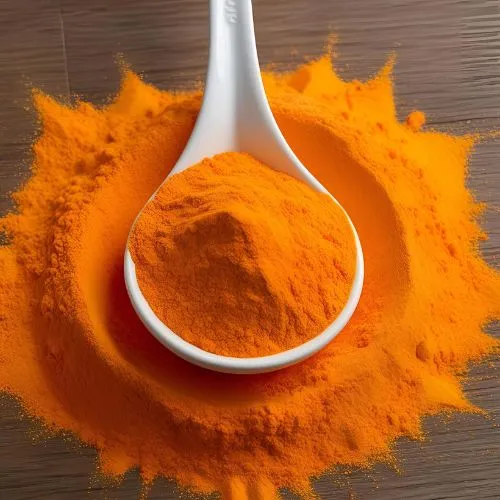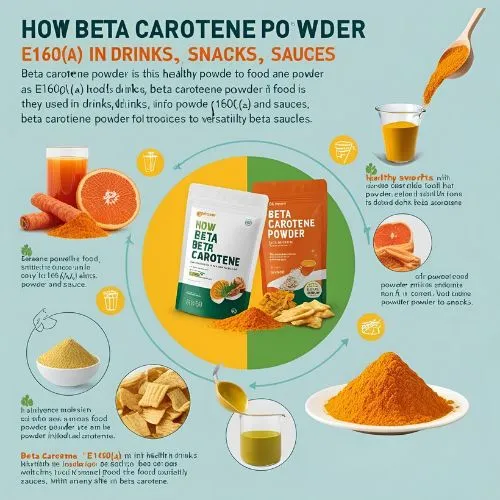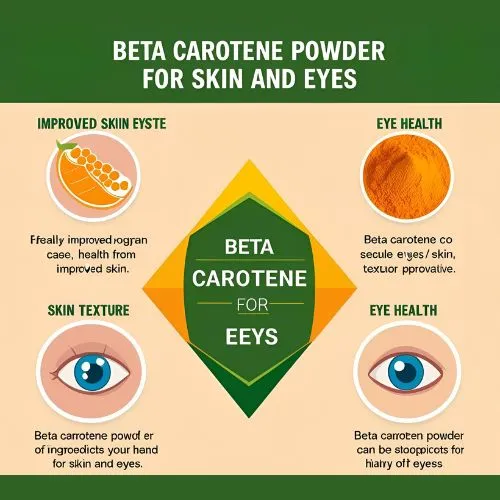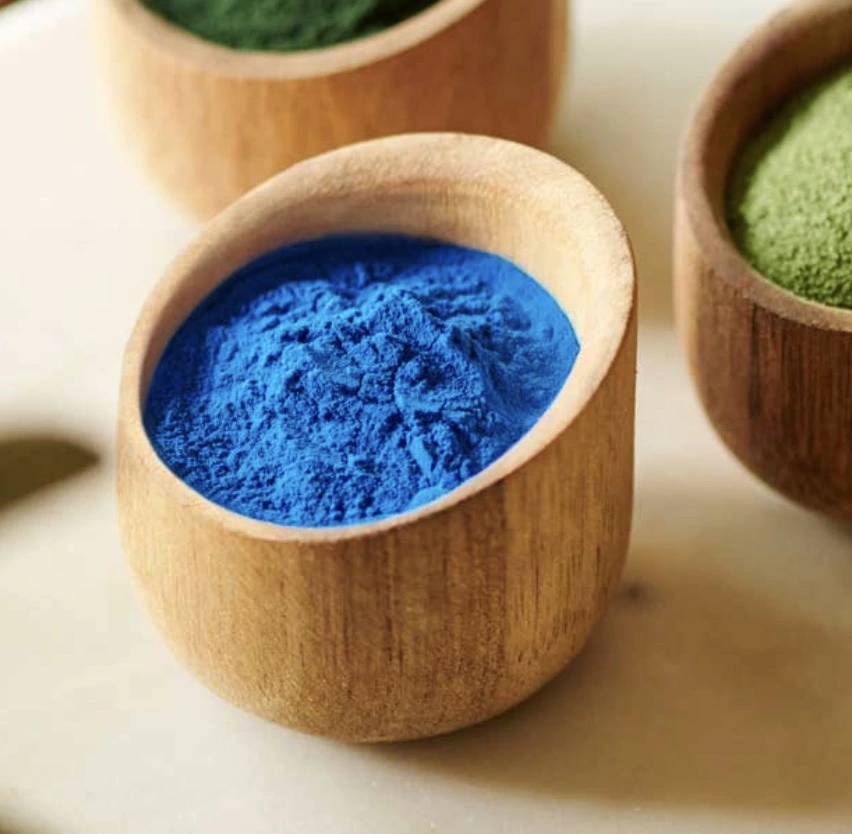Difference Between Natural and Synthetic Beta Carotene Powder
Beta carotene is a vibrant orange pigment found naturally in many fruits and vegetables. It's also widely used as a food coloring and nutritional supplement in the form of beta carotene powder. However, not all beta carotene powders are created equal. There are important differences between natural and synthetic versions that consumers should be aware of. In this comprehensive guide, we'll explore the key distinctions between natural and synthetic beta carotene powder E160(a), how they're used in foods, and their potential benefits for health and wellness.

How Beta Carotene Powder E160(a) Is Used in Foods?
Beta carotene powder, also known as E160(a), is a popular food additive used to impart a yellow-orange color to various products. Its versatility and stability make it an ideal coloring agent for a wide range of applications:
Common Food Uses
- Beverages: Fruit drinks, energy drinks, smoothies
- Dairy products: Cheese, yogurt, butter, margarine
- Baked goods: Cakes, cookies, breads
- Confectionery: Candies, chewing gum
- Sauces and dressings: Salad dressings, condiments
- Processed meats: Sausages, hot dogs
- Snack foods: Chips, crackers
Beta carotene powder not only enhances the visual appeal of foods but also serves as a source of vitamin A. The body converts beta carotene into vitamin A as needed, making it a valuable nutrient for eye health, immune function, and skin maintenance.
Regulatory Status
Beta carotene powder E160(a) is approved for use as a food additive in many countries worldwide. In the European Union, it's classified as a color additive and given the E number E160a. The FDA in the United States has approved beta carotene as a food coloring and nutrient supplement.
Production Methods
There are two primary ways to produce beta carotene powder E160(a) for commercial use:
- Natural extraction: Beta carotene is extracted from natural sources like carrots, algae, or palm oil using solvents or other separation techniques.
- Chemical synthesis: Beta carotene molecules are artificially created in a laboratory through chemical processes.
The production method significantly impacts the characteristics and potential benefits of the final beta carotene powder product.

Natural vs Synthetic E160(a): Which Is Better?
When it comes to beta carotene powder E160(a), there are notable differences between natural and synthetic versions. Understanding these distinctions can help consumers and manufacturers make informed choices:
Chemical Structure
While both natural and synthetic beta carotene have the same basic chemical formula (C40H56), their molecular structures differ slightly:
- Natural beta carotene exists as a mixture of various isomers, with all-trans beta carotene being the predominant form.
- Synthetic beta carotene typically consists of all-trans beta carotene only.
Bioavailability
Research suggests that natural beta carotene may be more bioavailable than its synthetic counterpart:
- Natural beta carotene is often found in combination with other carotenoids and natural compounds that may enhance absorption.
- The mixture of isomers in natural beta carotene may be more easily utilized by the body.
- Synthetic beta carotene lacks these synergistic compounds and may not be as readily absorbed.
Antioxidant Potency
Beta carotene powder E160(a) is valued for its antioxidant properties, but the effectiveness can vary:
- Natural beta carotene, with its diverse isomer profile, may offer broader antioxidant protection.
- Synthetic beta carotene, while still an antioxidant, may not provide the same range of benefits as the natural form.
Environmental Impact
The production methods for natural and synthetic beta carotene have different environmental implications:
- Natural extraction often relies on renewable plant sources and may have a lower carbon footprint.
- Synthetic production can be more resource-intensive and may involve the use of petrochemicals.
Cost Considerations
- Price is often a factor in choosing between natural and synthetic beta carotene:
- Synthetic beta carotene is generally less expensive to produce on a large scale.
Natural beta carotene extraction can be more costly due to the need for raw materials and complex processing.
Consumer Perception
In today's market, consumer preferences play a significant role:
- Many consumers prefer natural ingredients and may be willing to pay a premium for naturally-sourced beta carotene.
- The "clean label" trend favors natural beta carotene in food products marketed as wholesome or minimally processed.

Benefits of Beta Carotene Powder for Skin and Eyes
Regardless of its source, beta carotene powder offers numerous potential health benefits, particularly for skin and eye health:
Skin Health
Beta carotene's impact on skin health is well-documented:
- Sun protection: Beta carotene can act as an internal sunscreen, helping to protect skin cells from UV damage.
- Anti-aging: As an antioxidant, beta carotene may help reduce the appearance of fine lines and wrinkles.
- Skin tone: Regular consumption may contribute to a healthy, golden skin tone.
Eye Health
Beta carotene powder E160(a) plays a crucial role in maintaining healthy vision:
- Night vision: As a precursor to vitamin A, beta carotene is essential for the production of rhodopsin, a pigment necessary for night vision.
- Macular health: Beta carotene may help protect the macula from age-related degeneration.
- Cataract prevention: Some studies suggest that beta carotene intake may reduce the risk of cataracts.
Immune Function
Beta carotene's immune-boosting properties can benefit overall health:
- Supports the production and activity of immune cells
- May enhance the body's ability to fight off infections
Cardiovascular Health
Some research indicates potential cardiovascular benefits:
- May help reduce oxidation of LDL cholesterol
- Could contribute to lower risk of heart disease in some populations
Cognitive Function
Emerging research suggests beta carotene may support brain health:
- Potential protective effects against cognitive decline
- May help maintain memory and cognitive function in older adults
While both natural and synthetic beta carotene offer these potential benefits, some studies suggest that natural forms may be more effective due to their complex composition and synergistic effects with other nutrients.

Conclusion
The choice between natural and synthetic beta carotene powder E160(a) depends on various factors including intended use, desired benefits, and production considerations. While synthetic beta carotene offers cost-effectiveness and consistency, natural beta carotene may provide enhanced bioavailability and a broader spectrum of benefits. As consumer demand for natural ingredients grows, many manufacturers are opting for naturally-sourced beta carotene despite the higher cost.
Ultimately, both forms of beta carotene powder can contribute to vibrant food colors and potential health benefits. When choosing a beta carotene product, it's important to consider the specific application, target audience, and overall product positioning. For more information on high-quality beta carotene powder options, please contact Yangge Biotech Co., Ltd. at info@yanggebiotech.com.
References
1. Johnson, E. J., & Russell, R. M. (2010). Beta-Carotene. In Encyclopedia of Dietary Supplements (2nd ed., pp. 115-120). Informa Healthcare.
2. Grune, T., Lietz, G., Palou, A., Ross, A. C., Stahl, W., Tang, G., ... & Biesalski, H. K. (2010). β-Carotene is an important vitamin A source for humans. The Journal of Nutrition, 140(12), 2268S-2285S.
3. Bohn, T. (2008). Bioavailability of non-provitamin A carotenoids. Current Nutrition & Food Science, 4(4), 240-258.
4. Stahl, W., & Sies, H. (2012). β-Carotene and other carotenoids in protection from sunlight. The American Journal of Clinical Nutrition, 96(5), 1179S-1184S.
5. Eggersdorfer, M., & Wyss, A. (2018). Carotenoids in human nutrition and health. Archives of Biochemistry and Biophysics, 652, 18-26.

Based on your location and order quantity, you will have the opportunity to receive a limited time free shipping promotion!

Who we are


